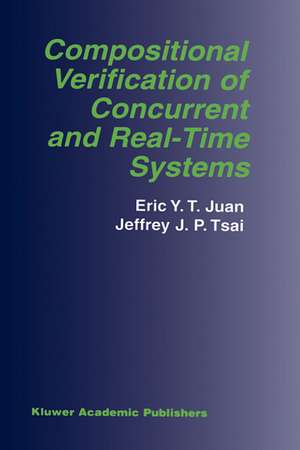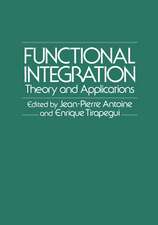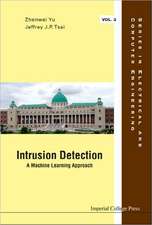Compositional Verification of Concurrent and Real-Time Systems: The Springer International Series in Engineering and Computer Science, cartea 676
Autor Eric Y.T. Juan, Jeffrey J. P. Tsaien Limba Engleză Hardback – 30 apr 2002
| Toate formatele și edițiile | Preț | Express |
|---|---|---|
| Paperback (1) | 641.67 lei 6-8 săpt. | |
| Springer Us – 26 oct 2012 | 641.67 lei 6-8 săpt. | |
| Hardback (1) | 648.26 lei 6-8 săpt. | |
| Springer Us – 30 apr 2002 | 648.26 lei 6-8 săpt. |
Din seria The Springer International Series in Engineering and Computer Science
- 24%
 Preț: 1041.98 lei
Preț: 1041.98 lei - 20%
 Preț: 643.50 lei
Preț: 643.50 lei - 18%
 Preț: 1225.62 lei
Preț: 1225.62 lei - 18%
 Preț: 965.02 lei
Preț: 965.02 lei - 20%
 Preț: 646.12 lei
Preț: 646.12 lei - 18%
 Preț: 948.79 lei
Preț: 948.79 lei - 20%
 Preț: 646.62 lei
Preț: 646.62 lei - 15%
 Preț: 637.46 lei
Preț: 637.46 lei - 20%
 Preț: 643.83 lei
Preț: 643.83 lei - 18%
 Preț: 949.23 lei
Preț: 949.23 lei - 20%
 Preț: 644.48 lei
Preț: 644.48 lei - 20%
 Preț: 994.92 lei
Preț: 994.92 lei - 20%
 Preț: 645.97 lei
Preț: 645.97 lei - 18%
 Preț: 946.87 lei
Preț: 946.87 lei - 20%
 Preț: 995.57 lei
Preț: 995.57 lei - 18%
 Preț: 956.99 lei
Preț: 956.99 lei - 20%
 Preț: 644.98 lei
Preț: 644.98 lei - 15%
 Preț: 649.54 lei
Preț: 649.54 lei - 18%
 Preț: 950.21 lei
Preț: 950.21 lei - 18%
 Preț: 1221.38 lei
Preț: 1221.38 lei - 18%
 Preț: 957.62 lei
Preț: 957.62 lei - 15%
 Preț: 643.99 lei
Preț: 643.99 lei - 18%
 Preț: 948.47 lei
Preț: 948.47 lei - 18%
 Preț: 947.35 lei
Preț: 947.35 lei - 20%
 Preț: 1284.65 lei
Preț: 1284.65 lei - 20%
 Preț: 1628.31 lei
Preț: 1628.31 lei - 20%
 Preț: 1285.78 lei
Preț: 1285.78 lei
Preț: 648.26 lei
Preț vechi: 810.33 lei
-20% Nou
Puncte Express: 972
Preț estimativ în valută:
124.06€ • 134.71$ • 104.21£
124.06€ • 134.71$ • 104.21£
Carte tipărită la comandă
Livrare economică 22 aprilie-06 mai
Preluare comenzi: 021 569.72.76
Specificații
ISBN-13: 9781402070259
ISBN-10: 140207025X
Pagini: 220
Ilustrații: XIX, 196 p.
Dimensiuni: 155 x 235 x 18 mm
Greutate: 0.49 kg
Ediția:2002
Editura: Springer Us
Colecția Springer
Seria The Springer International Series in Engineering and Computer Science
Locul publicării:New York, NY, United States
ISBN-10: 140207025X
Pagini: 220
Ilustrații: XIX, 196 p.
Dimensiuni: 155 x 235 x 18 mm
Greutate: 0.49 kg
Ediția:2002
Editura: Springer Us
Colecția Springer
Seria The Springer International Series in Engineering and Computer Science
Locul publicării:New York, NY, United States
Public țintă
ResearchCuprins
1. Introduction.- 1. Background.- 2. State Explosion.- 3. Compositional Verification.- 4. A Compositional Verification Methodology.- 5. Reduction Methods for Real-Time Systems.- 2. Verification Techniques for Concurrent Systems.- 1. Techniques for Efficient Analysis of Concurrent Systems.- 2. Compositional-Verification Techniques.- 3. Petri-Net Based Techniques for Real-Time Systems.- 3. Multiset Labeled Transition Systems.- 1. The Model.- 2. Communication Diagrams.- 3. Function “Parallel Composition” (?) of MLTSs.- 4. Function “Hiding Invisible Actions (Hide)” of MLTSs.- 5. Parallel Operation of MLTSs.- 4. Compositional Verification Using MLTS.- 1. Equivalences, Synonyms, and Congruences.- 2. Paths, Traces, and IO-Traces.- 3. IOT-Failures-Divergence (IOTFD) Equivalence.- 4. IOTFD-Equivalence Reduction.- 5. Algorithms and Proofs.- 5. Composotional Verification Using Petri Nets.- 1. The Models.- 2. Function “Parallel Composition”.- 3. Synonymous Reduction.- 4. Compositional Verification of Condensed MLTSs.- 5. Condensation Theories for State-Based Systems.- 6. Condensation Rules for IOT-State/IOT-Failure Equivalences.- 7. Firing Dependence Theories and Rules for MLTS*s.- 8. Compositional Verification of Sub-Marking Reachability.- 9. Definitions, Algorithms, and Proofs.- 6. Tools and Experiments.- 1. Alternating Bit Protocol (ABP).- 2. Tools.- 3. Performance Evaluation.- 7. Delay Time Petri Nets and Net Reduction.- 1. Time Petri Nets.- 2. Delay Time Petri Nets (DTPNs).- 3. Reduction Rules for DTPNs.- 4. Class Graphs of DTPNs.- 5. Efficiency Consideration and Experimental Results.- References.























